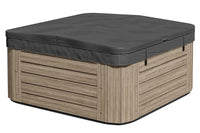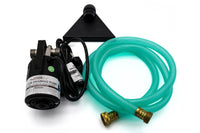Whether you are a new buyer or an existing owner, you might have questions about your hot tub’s water capacity.
Understanding water capacity is essential for a bevy of practical reasons, including hot tub maintenance, chemical balance, and water usage awareness. It's also handy to know around this time of year, when homeowners often drain and refill the tub regularly rather than running it throughout the cold season.
However, eyeballing the water amount can be notoriously tricky. (You can liken it to those jelly-bean jar guessing games you find at local fairs). Instead, you have to rely on either mathematical formulae, manual specifications, or both to determine the amount.
In this article, The Cover Guy covers everything you wanted to know about hot tub capacity. We answer the million-dollar question posed in the title: How many gallons of water go in a hot tub? We also delve deeper into why water capacity matters, whether you can over- or underfill a tub, and how you can conserve water when you buy hot tub covers built for strength and energy retention.
Unkink your garden hose, and let’s get started.
The Basics: What Factors Influence Hot Tub Water Capacity?
First, understand that several factors can influence a hot tub’s water capacity. Here’s where we freely admit that the question posed in the title has no fixed, universal answer. Obviously, gallon capacity varies from spa to spa.
Here are a few basic factors that determine how many gallons of water go in a hot tub:
- Size and Shape: Hot tub capacity is largely determined by its size (length, width, and depth) and shape (round, square, rectangular). Larger tubs hold more water, while compact tubs for 2-3 people hold less.
- Seating Capacity: The number of seats in the hot tub impacts water volume. Obviously, a 2-person tub typically holds fewer gallons compared to a 6-person or 8-person tub. But also, be mindful that seating displaces water, reducing the total volume the tub can hold compared to its raw, empty capacity.
- Water Depth and Fill Line: Different models have different water depths and fill lines, both of which affect how much water is required.
- Jets and Plumbing: Like seating, jets and plumbing reduce the water capacity of a hot tub because they take up space that would otherwise be filled with water. Jets and internal components also require water circulation, which can slightly alter how much water is needed for optimal performance.
With those factors under our belts, we can move on to averages and calculations.
Ballpark Figures: Average Water Capacities Based on Hot Tub Sizes
If you came to this article looking for a rough estimate, you’ve reached the right section! Sometimes, all a tub owner needs are ballpark figures that they can use as they calculate their likely utility costs and chemical purchases.
Here are a few averages you can use:
- Small Hot Tubs for two to three people: Smaller models usually hold around 150-300 gallons of water.
- Medium Hot Tubs built for four to six people: These medium-sized hot tubs often hold between 300-500 gallons of water.
- Large Hot Tubs for seven people and above: Larger models, such as those designed for 7-8 people, typically require 500-900 gallons of water. However, the sky’s the limit here.
- Swim Spas: The larger capacities of swim spas can hold well over 1,000 gallons of water.
- Custom Hot Tubs: Finally, there are custom-built hot tubs, which are challenging to ballpark since they vary significantly in size, shape, and internal features. Refer to the seating capacities above to glean a rough estimate for your spa.
If all you need is an estimate, you can use the figures above. For more exact measurements, keep on reading.
How to Calculate Your Hot Tub’s Water Capacity
If you don’t have a manual with manufacturer’s information or you custom-built your spa, you can still use a couple of handy formulae to determine how many gallons go into your hot tub. To pull it off, you need a calculator and measuring tape.
Here’s a straightforward step-by-step guide:
Step 1: Measure the Dimensions of the Tub
Measure the length, width, and depth of your hot tub in feet (or meters, for our international readers). Jot these figures down on a notepad or the notes app on your phone.
Step 2: Apply the Volume Formula
Take your figures and punch them into one of the following formulae:
- For rectangular or square tubs, use the formula: Length x Width x Average Depth x 7.5. The resulting sum will tell you how many gallons of water go into your hot tub.
- For circular tubs, use the formula: 3.14 x Radius² x Average Depth x 7.5 = Gallons of Water. Again, the resulting sum will tell you how many gallons of water go into your hot tub. If you don’t want to fiddle with a calculator, use this pool volume calculator instead.
Step 3: Adjust for Seating and Features
The calculation may need slight adjustments if the hot tub has built-in seats, jets, or unique design features. You can fiddle with your measuring tape again to get exact subtractions; however, subtracting around 10-20% from the total volume does a decent job of accounting for these design elements.

Manufacturer Recommendations: Using Spec Sheets for Water Capacity
"I gave up math in high school and never looked back," you might be saying to yourself. No problem—if available, you can consult the manufacturer's recommendation for gallon capacity.
Refer to the owner’s manual that came with your tub when you purchased it. Water capacity is typically one of the first specs a manual mentions; however, you may need to flip through a few sections to find the information.
If you purchased a hot tub manufactured in another country (or you count yourself among our many international readers!), you might need to convert liters to gallons. Multiply the liter capacity by 0.264172 to determine the gallon capacity. (Or just use this unit converter online).
Finally, if you’ve scoured your home and the internet and failed to find the manual, reach out to the manufacturer. Most manufacturers have customer service lines that are more than happy to answer a basic capacity query or—at the very least—point you in the direction of a digital owner’s manual.
Why Water Capacity Matters: Practical Considerations for Hot Tub Owners
Hopefully, you’ve figured out your tub’s water capacity, either by ballparking it, measuring, or researching the owner’s manual.
The next question out of your mouth might be, “When is this information relevant?” Water capacity is vital for a few reasons, which we’ve highlighted below:
- Chemical Balancing: Accurate water capacity is essential for balancing chemicals. Adding too much or too little sanitizer, pH balancers, or other chemicals can affect water quality, equipment longevity, and user comfort. And since chemical amounts are measured relative to water (as a solution), capacity directly impacts chemical usage.
- Water and Energy Efficiency: Understanding the water capacity can help you make smarter decisions about water usage, refilling schedules, and energy efficiency. Especially for tub owners aiming to limit their environmental impact (or those who live in areas with mandatory water restrictions, like much of California), water capacity is a major concern.
- Maintenance and Drainage: Knowing your spa’s volume is crucial for planning regular maintenance tasks like draining and refilling, and regularly cleaning your hot tub. For more information on cleaning, and how to properly drain your hot tub or fill your hot tub, visit the three links provided in this bullet point.
- Overfilling and Underfilling Risks: Lastly, water capacity matters because an improperly filled tub poses certain risks to people and equipment. Overfilling can cause water to spill out when people enter, potentially damaging electrical components or nearby surfaces. Meanwhile, underfilling a hot tub can reduce the effectiveness of jets, pumps, and hot tub filters, leading to uneven water heating and circulation problems. Follow the “fill line” (typically marked on the side of the tub) or follow the measurement guidelines in the sections above to fill your tub to its optimal level.
In short, it always pays to know how many gallons of water go into your hot tub. Luckily, with the ballpark averages, formulae, and manual tips above, you’ll never be in the dark.
Water-Saving Tips: How to Conserve Water While Enjoying Your Hot Tub
Finally, as experts on all things hot tubs, we here at The Cover Guy get a lot of questions about water conservation. It isn’t enough to know how many gallons go into the spa; people want to know how they can keep those gallons in.
Naturally, we direct people’s attention to a quality, custom-built hot tub cover. The covers we offer are custom-made with superior heat retention, heat-sealed foam, marine-grade vinyl, and double-stitching, all of which prevent evaporation so that you can reduce your water and energy consumption.
Next, we recommend that you practice regular water maintenance. Make appointments in your physical or digital calendar to test your water, maintain proper water chemistry, and clean or replace your filters to extend the life of the water between drains.
Lastly, consider strategic refilling. Provided you aren’t dealing with cloudy water or other severe water issues, you can partially refill the hot tub instead of fully draining it. You'll just need to make a note of how much water you drain and replace, which will inform your new chemical balance equations.
To summarize, it’s essential to understand your hot tub’s water capacity, not just for the practical aspects like chemical balancing and maintenance, but for water conservation and efficiency. Follow the guidelines above to protect your investment, fill that spa to its optimal level, and enjoy a hassle-free hot tub experience!









